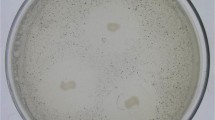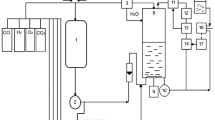Abstract
After polyhydroxyalkanoate (PHA) fermentation for 42 –48 h by theAzotobacter chroococcum G-3, the PHA content reached more than 75% of the dry weight. Biomass was isolated from culture by centrifugation and pretreated with freezing to release PHA pellet, then was treated with 10 g/L sodium dodecyl sulfate (SDS) for 15 min to effectively solubilize lipid and protein. Subsequently, it was further purified by digesting with 30% sodium hypochlorite (NaClO) for 3 min to remove peptidoglycan and non-PHA biomass. Finally, 98% PHA was obtained by diluting and rinsing with water, and the PHA recovered was suitable for processing.
Similar content being viewed by others
References
Anderson, A. J., Dawes, E. A., Metabolism, metabolic roles, and industrial use of bacterial polydroxyalkanoates, Microbiological Reviews, 1990, 54(4): 450.
Ling, Y., Wang, H. et al., Pilot-scale extraction of PHB from recombinantE. coli by homogenization and centrifugation, Bioseparation, 1997, 7: 9.
Ramsay, J. A., Berger, E., Voger, R. et al., Extraction of poly-3-hydyoxybutyrate using chlorinated solvents, Biotechnol. Tech., 1994, 8: 589.
Holmes, P. A., Lim, G. B., Separation process, US Patent, 1990, 4 910145.
Berger, E., Ramsay, B. A., Ramsay, J. A. et al., PHB recovery by hypochlorite digestion of non-PHB biomass, Biotecnol. Tech., 1989, 3: 227.
Hahn, S. K., Chang, Y. K., Kim, B. S. et al., Optimization of microbial poly (3-hydroxybutyrate) recovery using dispersions of sodium hypochlorite solution and chloroform, Biotechnol. Bioeng., 1994, 44: 256.
Ramsay, J. A., Berger, E., Ramsay, B. A. et al., Recovery of poly-3-hydroxyalkanoic granules by a surfactant-hypochlorite treatment, Biotech. Tech., 1990, 8: 589.
Ramsay, J. A., Berger, E., Ramasy, B. A. et al., Recovery of poly-3-hydroxyalkanoic granules by a surfactant-hypochlorite treatment, Biotech. Tech., 1990, 4: 221.
Braunegg, G., Sonnleitner, B., Latterly, R. M., A rapid gas Chromatographic method for the determination of poly-β-hydroxybutyric acid in microbial biomass, Eur. J. Appl. Microbiol. Biotechnol., 1978, 6: 29.
Gu, J. E., Principles of Separation and Purification Technology (in Chinese), Beijing: Chinese Medical Science Press, 1994.
Li, J. W., Xiao, N., Yu, R. Y. et al., Principles and methods of biochemical experiment, Beijing: Peking University Press, 1994.
Author information
Authors and Affiliations
About this article
Cite this article
Dong, Z., Sun, X. A new method of recovering polyhydroxyalkanoate fromAzotobacter chroococcum . Chin.Sci.Bull. 45, 252–256 (2000). https://doi.org/10.1007/BF02884685
Received:
Issue Date:
DOI: https://doi.org/10.1007/BF02884685




